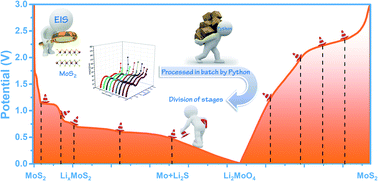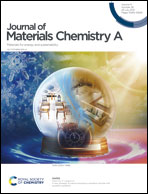Clarifying the lithium storage behavior of MoS2 with in situ electrochemical impedance spectroscopy†
Abstract
MoS2 is considered a potential electrode material for lithium-ion batteries because of its high energy density. However, it has not been commercialized owing to its poor cycle stability. To explore the reasons for its poor cycle stability, in situ X-ray diffraction, in situ transmission electron microscopy, and other characterization methods were used to explore the lithium storage mechanism and the phase transitions of MoS2 during lithium storage. Because MoS2 forms an amorphous structure during cycling, these physical methods have difficulty distinguishing between the various electrochemical stages of the reaction in detail. In this work, in situ electrochemical impedance spectroscopy (EIS) was adopted to record the change in the impedance of the MoS2 electrode during the discharging and charging processes. The results show that the first discharging and charging process of MoS2 can be further divided into six stages and five stages, respectively. In addition, a program based on Python was used to batch-process EIS data, which promotes the further application of in situ EIS. This study can help researchers analyze the lithium storage process of MoS2 in more detail than was previously possible, and this method can also be applied to mechanistic research on other electrode materials.



 Please wait while we load your content...
Please wait while we load your content...